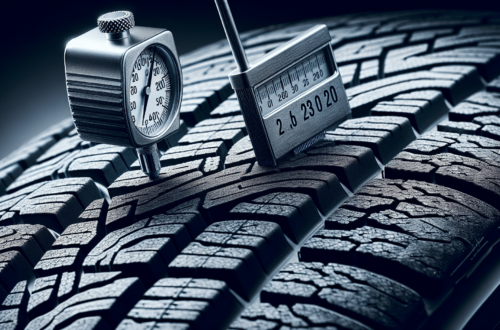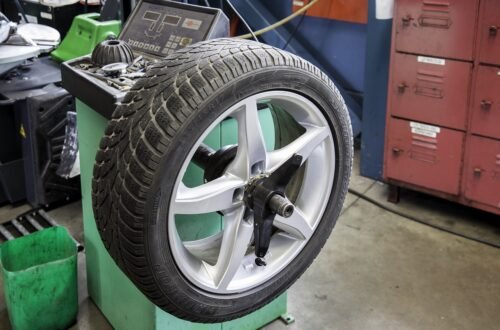In the quest for safer roads, one cannot overlook the crucial role that proper tire tread depth plays. Whether you are a seasoned driver or a novice behind the wheel, having the right tread depth is essential for maintaining control, preventing accidents, and ensuring your safety on the road. In this article, we will explore the importance of tire tread depth, how to measure it accurately, and why regularly checking and maintaining it is vital for maximizing safety. So buckle up and get ready to discover the key to safer driving!
What is Tire Tread Depth?
Definition of Tire Tread Depth
Tire tread depth refers to the measurement of the depth of the grooves on the surface of your tires. These grooves, also known as the tread, play a crucial role in maintaining traction and control on the road. The depth of the tread dictates how well your tires can grip the road surface, especially in wet or slippery conditions. Adequate tread depth is vital for optimal performance and safety while driving.
Importance of Tire Tread Depth
Maintaining proper tire tread depth is essential for several reasons. First and foremost, it directly affects your vehicle’s ability to grip the road. The channels between the tire treads are designed to expel water, snow, and other debris, preventing hydroplaning and ensuring traction. Without sufficient tread depth, your tires may struggle to maintain contact with the road, leading to reduced control, increased stopping distances, and an increased risk of accidents.
How to Measure Tire Tread Depth
Using a Tire Tread Depth Gauge
The most accurate way to measure tire tread depth is by using a tire tread depth gauge. These handy tools can be found at automotive stores and are relatively inexpensive. To use a gauge, simply press the probe into one of the tire’s grooves until it reaches the base. The gauge will then display the depth measurement, typically in millimeters or 32nds of an inch. Repeat this process for multiple locations across the tire to ensure an accurate assessment of overall tread depth.
Using a Penny
If you don’t have a tire tread depth gauge, a penny can be used as a quick and simple alternative. Insert the penny into one of the tire grooves with Lincoln’s head facing downward. If Lincoln’s head is fully visible, this indicates that your tire tread depth is too shallow. However, if the top of Lincoln’s head is partially covered, it suggests that you still have some usable tread depth remaining.
Using the Wear Bars
Most modern tires are equipped with wear bars that serve as built-in indicators of tire replacement. These bars are located at the base of the grooves and become visible as the tire tread wears down. If the wear bars are even with the surrounding tread, it is an indication that your tire has reached the minimum acceptable tread depth and needs to be replaced.

This image is property of images.pexels.com.
When to Check Tire Tread Depth
Recommended Frequency of Checking
To ensure your safety on the road, it is advisable to check your tire tread depth at least once a month. Regular inspections allow you to monitor tread wear and catch any potential issues before they become critical. Additionally, it is essential to check tread depth before embarking on long road trips or during seasonal changes when road conditions may differ.
Signs that Indicate the Need for Checking
Aside from regular inspections, several signs indicate the need for immediate tire tread depth checks. Uneven tire wear, such as bald spots or excessive wear on certain areas, suggests tire misalignment or improper rotation. Additionally, if you notice your vehicle hydroplaning or losing traction on wet roads, it may indicate insufficient tread depth. Lastly, if you frequently experience longer braking distances or difficulty maintaining control while driving, your tire tread depth could be a contributing factor.
Legal Tread Depth Requirements
Minimum Tread Depth Laws
Different jurisdictions have specific regulations regarding the minimum allowable tire tread depth. In many countries, including the United States, the minimum legal tread depth requirement is typically 2/32 of an inch (approximately 1.6 millimeters). However, it is important to note that the actual legal requirements can vary between states and regions. It is always recommended to familiarize yourself with the specific regulations applicable to your location.
Penalties for Driving with Insufficient Tread Depth
Driving with tires that have tread depths below the legal requirement can result in serious consequences. Depending on your jurisdiction, you may face fines, points on your driver’s license, or even a suspension of driving privileges. Moreover, inadequate tread depth significantly increases the risk of accidents, as the tires are more prone to slipping and losing control. It is crucial to prioritize the safety of yourself, your passengers, and other road users by ensuring your tires meet the legal tread depth requirements.

This image is property of images.pexels.com.
Effects of Insufficient Tire Tread Depth
Reduced Traction and Control
When your tires have insufficient tread depth, particularly in wet or icy conditions, they lose their ability to grip the road effectively. This results in reduced traction and control over your vehicle. The grooves in the tire tread are designed to disperse water and debris, allowing the tire to maintain contact with the road surface. Without adequate tread depth, the tires become unable to channel away water, leading to a higher risk of hydroplaning and a loss of control while driving.
Increased Stopping Distance
Proper tire tread depth significantly affects your vehicle’s braking distance. Tires with ample and intact tread can grip the road, providing the necessary friction to stop your vehicle promptly. However, inadequate tread depth decreases the tire’s ability to generate sufficient friction, causing a longer stopping distance. This can be especially dangerous in emergency situations, where every inch of stopping distance counts.
Aquaplaning and Hydroplaning Risks
Aquaplaning (also known as hydroplaning) occurs when your tires lose contact with the road surface and glide over a layer of water, resulting in a complete loss of traction. Insufficient tire tread depth significantly increases the risk of aquaplaning, as the grooves that would usually channel away water are too shallow. Hydroplaning can cause your vehicle to spin out of control, leading to dangerous accidents.
Maximizing Tire Tread Life
Proper Inflation and Alignment
Maintaining proper tire inflation and alignment is crucial for maximizing the lifespan of your tire tread. Underinflated or overinflated tires wear unevenly, leading to premature tread wear. Furthermore, misaligned tires can cause excessive wear on specific areas of the tread. Regularly checking and maintaining the correct tire pressure and ensuring proper wheel alignment will help promote even tread wear and extend the life of your tires.
Regular Rotation and Balance
Rotating your tires at the recommended intervals is essential for even tread wear. Front tires tend to wear differently than rear tires due to variations in weight distribution and steering forces. By rotating your tires regularly, you distribute the wear evenly, ensuring that all tires maintain sufficient tread depth. Additionally, balancing your tires during rotation helps prevent uneven wear patterns and extends their overall lifespan.
Avoiding Excessive Speed and Aggressive Driving
Excessive speed and aggressive driving habits have detrimental effects on tire tread life. High speeds generate more heat, which can accelerate tread wear. Moreover, aggressive driving maneuvers, such as quick stops, hard accelerations, and abrupt turns, put additional stress on the tires. By practicing defensive driving techniques and maintaining reasonable speeds, you can minimize wear on your tires, allowing them to maintain optimal tread depth for a more extended period.

This image is property of images.pexels.com.
Tire Tread Depth and Weather Conditions
Impacts of Different Weather Conditions
Tire tread depth plays a crucial role in providing adequate traction on various weather conditions. In dry conditions, the tread channels help maintain a strong grip on the road surface, ensuring excellent handling and control. In wet conditions, the grooves work to disperse water, reducing the risk of hydroplaning and improving overall traction. In snowy or icy conditions, deep tire treads are essential for digging into the snow and providing the necessary traction for safe driving.
Winter Tires and Snow Traction
In regions with harsh winter climates, it is highly recommended to invest in winter tires. Winter tires are specifically designed with deeper and more aggressive tread patterns to provide superior traction on snow and ice. The enhanced tread design helps the tires bite into the snowy surface, improving control and reducing the risk of skidding or getting stuck. Winter tires, combined with adequate tread depth, are a critical component in ensuring safe driving in snowy conditions.
Visual Inspection and Warning Signs
Cracks, Bulges, and Uneven Wear Patterns
In addition to measuring the tread depth, it is important to visually inspect your tires for any signs of damage or wear. Cracks, bulges, or cuts in the sidewalls can indicate structural damage, compromising the tire’s integrity. Uneven wear patterns, where certain areas of the tread are more worn than others, suggest misalignment or other underlying issues. If you notice any of these warning signs during your inspection, it is crucial to have your tires inspected by a professional to determine the appropriate course of action.
Provided Tread Wear Indicator Bars
Most modern tires are equipped with tread wear indicator bars located within the grooves. These bars become visible as the tire tread wears down, indicating when it is time to replace the tire. If the tread is level with these bars, it signifies that the tire has reached the minimum allowable tread depth and should be replaced promptly. Tread wear indicators are a helpful visual cue for drivers, reminding them to keep an eye on their tire tread depth and prioritize safety.
Replacing Tires with Insufficient Tread Depth
When to Replace Tires
Once your tires reach the minimum allowable tread depth, it is crucial to replace them promptly. While the legal requirement may be the absolute minimum, it is advisable to replace tires before they reach this point to ensure optimal safety on the road. Regularly monitoring and measuring your tire tread depth will allow you to plan for replacement in a timely manner, preventing any compromise in traction, control, or braking performance.
Choosing the Right Tire Tread Depth
When replacing your tires, it is essential to choose the appropriate tread depth for your specific needs. If you frequently encounter harsh weather conditions, such as snow or heavy rain, opting for tires with deeper tread patterns is advisable. On the other hand, if you live in a predominantly dry climate, tires with slightly shallower tread may provide adequate performance without sacrificing longevity. Consider factors such as climate, driving habits, and the manufacturer’s recommendations when selecting the right tire tread depth for your vehicle.
Conclusion
Importance of Maintaining Proper Tire Tread Depth
Maintaining proper tire tread depth is vital for your safety on the road. Adequate tread depth ensures optimal traction, control, and braking performance, especially in wet or slippery conditions. Regularly checking your tire tread depth and replacing tires when necessary will help maximize your safety and reduce the risk of accidents.
Safety Benefits of Maximizing Tire Tread Depth
Maximizing tire tread depth provides several safety benefits. It improves grip and control on the road, reduces stopping distances, and minimizes the risk of hydroplaning and accidents. By maintaining optimal tire tread depth and following recommended maintenance practices, you prioritize your safety and the safety of others on the road. Remember, your tires are the only point of contact between your vehicle and the road, making proper tire tread depth a critical aspect of safe driving.





